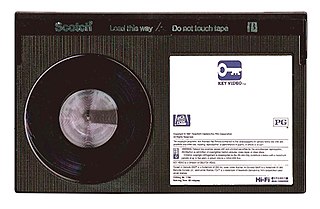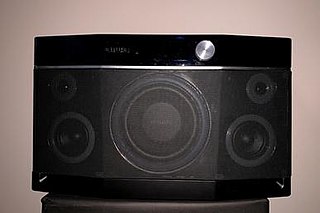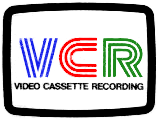
VHS is a standard for consumer-level analog video recording on tape cassettes.

Digital Audio Tape is a signal recording and playback medium developed by Sony and introduced in 1987. In appearance it is similar to a Compact Cassette, using 3.81 mm / 0.15" magnetic tape enclosed in a protective shell, but is roughly half the size at 73 mm × 54 mm × 10.5 mm. The recording is digital rather than analog. DAT can record at sampling rates equal to, as well as higher and lower than a CD at 16 bits quantization. If a comparable digital source is copied without returning to the analogue domain, then the DAT will produce an exact clone, unlike other digital media such as Digital Compact Cassette or non-Hi-MD MiniDisc, both of which use a lossy data reduction system.

The Victor Company of Japan, Limited, usually referred to as JVC or the Japan Victor Company, is a Japanese brand owned by JVCKenwood corporation. Founded in 1927, the company is best known for introducing Japan's first televisions and for developing the Video Home System (VHS) video recorder.

S-VHS (スーパー・ヴィエイチエス), the common initialism for Super VHS, is an improved version of the VHS standard for consumer-level video recording. Victor Company of Japan introduced S-VHS in Japan in April 1987 with their JVC-branded HR-S7000 VCR, and in certain overseas markets soon afterward. Shortly, later in the same year of 1987, first S-VHS VCR models from other competitors included Hitachi VT-2700A, Mitsubishi HS-423UR, Panasonic PV-S4764, RCA VPT-695HF, and Toshiba SV-950.

Betamax is a consumer-level analog-recording and cassette format of magnetic tape for video, commonly known as a video cassette recorder. It was developed by Sony and was released in Japan on May 10, 1975, followed by the US in November of the same year.

Video 2000 is a consumer videocassette system and analogue recording standard developed by Philips and Grundig to compete with JVC's VHS and Sony's Betamax video technologies. Designed for the PAL color television standard, distribution of Video 2000 products began in 1979 exclusively in Europe, South Africa and Argentina and ended in 1988.
Nakamichi Corp., Ltd. is a Japanese consumer electronics brand that originated in Japan and gained a name from the 1970s onwards for innovative and high quality audio cassette decks. Nakamichi is a subsidiary of Chinese holding company Nimble Holdings.

Aiwa (アイワ) is a consumer electronics brand owned and used by various companies in different regions of the world. American and other regions are owned by Chicago-based Aiwa Corporation. Towada Audio based in Tokyo owns rights in Japan and elsewhere and has been manufacturing Aiwa-branded products since 2017. In Mexico and other countries in Latin America, rights are owned by Audio Mobile Americas, S.A.

NEC Corporation is a Japanese multinational information technology and electronics corporation, headquartered in Minato, Tokyo. The company was known as the Nippon Electric Company, Limited, before rebranding in 1983 as NEC. It provides IT and network solutions, including cloud computing, AI, IoT platform, and telecommunications equipment and software, to business enterprises, communications services providers and to government agencies, and has also been the biggest PC vendor in Japan since the 1980s, when it launched the PC-8000 series.

Video Cassette Recording (VCR) is an early domestic analog recording format designed by Philips. It was the first successful consumer-level home videocassette recorder (VCR) system. Later variants included the VCR-LP and Super Video (SVR) formats.

The videotape format war was a period of competition or "format war" of incompatible models of consumer-level analog video videocassette and video cassette recorders (VCR) in the late 1970s and the 1980s, mainly involving the Betamax and Video Home System (VHS) formats. VHS ultimately emerged as the preeminent format.

U-matic is an analogue recording videocassette format first shown by Sony in prototype in October 1969, and introduced to the market in September 1971. It was among the first video formats to contain the videotape inside a cassette, as opposed to the various reel-to-reel or open-reel formats of the time. The videotape is 3⁄4 in (19 mm) wide, so the format is often known as "three-quarter-inch" or simply "three-quarter", compared to open reel videotape formats in use, such as 1 in (25 mm) type C videotape and 2 in (51 mm) quadruplex videotape.

The Japanese electronics industry is one of the largest in the world, though the share of Japanese electronics companies has significantly declined from its peak due to competition from South Korea, Taiwan, China, and the United States. Japan still has a number of companies that produce television, camcorders, audio and video players, etc.
Hanwha Techwin, founded as Samsung Techwin, is a video surveillance company. It is a subsidiary of Hanwha Group. The company employs 1,822 people and is headquartered in South Korea. Its total sales in 2020 were 529.8 billion South Korean won.

Dual is a brand name of audio and video electronics.

Funai Electric Co., Ltd. is a Japanese consumer electronics company headquartered in Daitō, Osaka. Apart from producing its own branded electronic products, it is also an OEM providing assembled televisions and video players/recorders to major corporations such as Sharp, Toshiba, Denon, and others. Funai supplies inkjet printer hardware technology to Dell and Lexmark, and produces printers under the Kodak name.

A videocassette recorder (VCR) or video recorder is an electromechanical device that records analog audio and analog video from broadcast television or other source on a removable, magnetic tape videocassette, and can play back the recording. Use of a VCR to record a television program to play back at a more convenient time is commonly referred to as timeshifting. VCRs can also play back prerecorded tapes. In the 1980s and 1990s, prerecorded videotapes were widely available for purchase and rental, and blank tapes were sold to make recordings.
Shintom Industries Co. Ltd. was a Japanese consumer electronics company headquartered in Yokohama, Japan, first founded in 1955 and ended in 2004, after filing for Chapter 7 bankruptcy. Shintom was engaged in the development, manufacture, and sale of mobile phone, car audio, transistor radio, videocassette recorder, measuring instrument, and medical equipment. Shintom had two factories worldwide, located both in Japan and Indonesia. Shintom first held a stake with Audiovox in 1980 as an OEM supplier for Audiovox car stereos.

Samsung Electronics Co., Ltd. is a South Korean multinational electronics corporation headquartered in the Yeongtong District of Suwon. It is the pinnacle of the Samsung chaebol, accounting for 70% of the group's revenue in 2012. Samsung Electronics has played a key role in the group's corporate governance due to circular ownership. Samsung Electronics has assembly plants and sales networks in 74 countries and employs around 290,000 people. It is majority-owned by foreign investors. As of 2019, Samsung Electronics is the world's second largest technology company by revenue, and its market capitalization stood at US$520.65 billion, the 12th largest in the world.
Dixon Technologies (India) Ltd is an Indian electronics manufacturing services company, based in Noida. It is a contract manufacturer of televisions, washing machines, smartphones, LED bulbs, battens, downlighters and CCTV security systems for companies such as Samsung, Xiaomi, Panasonic and Philips. It has 10 manufacturing units in Noida, Dehradun and Tirupati, as well as the largest television, washing machine and bulb assembly plants in India. The company is listed on BSE and NSE since its initial public offering in 2017.















